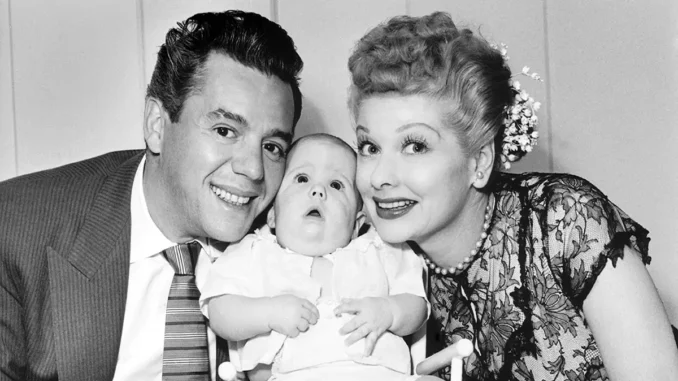
A Day That Changed Television — and Lucille Ball’s Life
January 19, 1953, remains one of the most remarkable dates in television history. On that day, I Love Lucy aired one of its most anticipated episodes, “Lucy Goes to the Hospital,” where Lucy Ricardo gave birth to her son, Little Ricky. What made this episode even more extraordinary was that earlier that same morning, actress Lucille Ball gave birth in real life to her own son, Desi Arnaz Jr. The coincidence blurred the lines between fiction and reality in a way that had never happened before — and made TV history.
A Perfectly Timed Miracle
The timing was almost unbelievable. CBS had scheduled the “Lucy Goes to the Hospital” episode months in advance, and the storyline had been carefully coordinated with Ball’s real-life pregnancy. At 11:00 a.m. on January 19, Lucille gave birth via cesarean section at Cedars of Lebanon Hospital in Los Angeles. Just hours later, that same evening, millions of Americans tuned in to watch Lucy Ricardo deliver her baby on television.
It was a historic cultural moment — the first time that a real-life pregnancy and an on-screen one had aligned so perfectly. More than 44 million viewers — nearly 72% of the nation’s TV audience — watched the episode, breaking all previous television ratings records. In fact, more Americans watched Lucy’s delivery than tuned in for President Eisenhower’s inauguration the following day.
Breaking Boundaries for Women on TV
At the time, it was still controversial for a pregnant woman to appear on television. In the 1950s, even the word “pregnant” was considered too explicit for broadcast — CBS insisted on using the term “expecting.” Despite the restrictions, Lucille Ball and her husband Desi Arnaz, who also played her on-screen spouse Ricky Ricardo, fought for authenticity.
They believed the show should reflect real life — and that Lucy Ricardo, a married woman on TV, could have a baby just like any other wife. With careful planning and approval from CBS and religious advisors, I Love Lucy became the first American sitcom to depict a pregnancy storyline, paving the way for more honest portrayals of women on television.
Desi Arnaz’s Touch: Turning Life Into Art
Desi Arnaz wasn’t just Lucille’s husband; he was also a creative force behind the series. He helped craft the idea that Lucy Ricardo’s baby should arrive at the same time as their real child. The couple even decided to name their fictional baby Ricky Ricardo Jr. to mirror their son’s name, Desi Arnaz Jr.
This blending of reality and fiction deepened fans’ emotional connection to the show. Viewers felt like they were part of the Ricardos’ extended family — celebrating their joy both on-screen and off. It was an ingenious move that elevated I Love Lucy from just a sitcom to a cultural phenomenon.
A Nation Celebrates With Lucy
The morning after the episode aired, newspapers across America ran headlines like:
“Lucy’s Baby Boy Arrives in Real Life!”
The public was genuinely overjoyed, sending Lucille Ball more than 30,000 congratulatory letters in just a few days. Even the New York Times and Los Angeles Times covered the event on their front pages — treating it as national news rather than mere entertainment.
For audiences of the 1950s, Lucy Ricardo’s pregnancy felt personal. Week after week, viewers had laughed, cried, and rooted for her. When she finally became a mother — both on television and in reality — the line between performer and persona disappeared completely.
The Legacy of a Groundbreaking Episode
“Lucy Goes to the Hospital” remains one of the most-watched and beloved episodes in TV history. But beyond ratings, it stands as a cultural milestone — a moment when television dared to mirror real life. Lucille Ball’s courage to share her own experience so publicly helped normalize motherhood on screen and opened doors for generations of actresses to come.
She wasn’t just playing a character; she was redefining what women could be on television — strong, funny, loving, and authentically human.
A Love Story Beyond the Screen
Behind the scenes, the day symbolized the peak of Lucille Ball and Desi Arnaz’s love story. Though their marriage would later face challenges, in 1953, they were America’s favorite couple — partners in both art and life. Their shared joy over the birth of their son, and the shared success of I Love Lucy, marked a rare fusion of personal triumph and professional legacy.
The Moment That Made TV History
Looking back, January 19, 1953, wasn’t just another day in Hollywood — it was the day television grew up. Lucille Ball’s dual role as a real and fictional mother proved that comedy could carry emotional depth, that television could reflect real lives, and that audiences were ready for authenticity.
More than seventy years later, the episode continues to be celebrated — not only for its humor but for its heart. Lucille Ball didn’t just make history that day; she made motherhood, television, and laughter forever inseparable.
